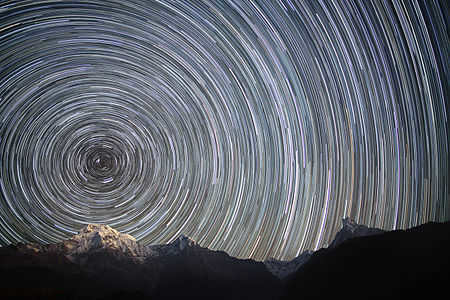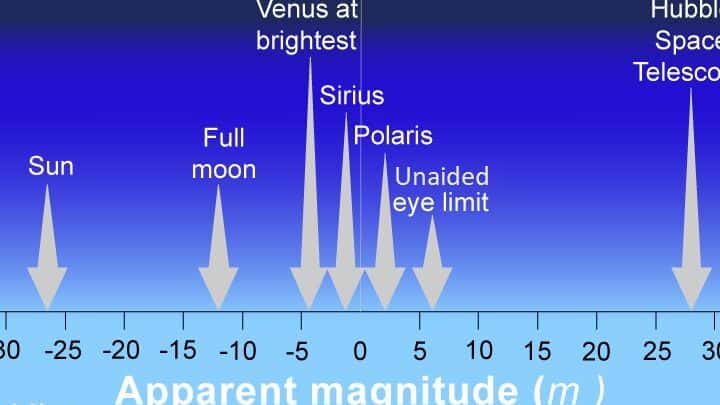During the night, a multitude of stars become visible in the sky. Certain stars emit a stronger radiance, while others appear fainter, even when observed without any optical aids. Astronomers refer to the brightness of celestial objects as brilliance and possess the ability to quantify it through the measurement of stellar magnitude.
What does stellar magnitude mean?
Stellar magnitude serves as a measure of the brightness levels of stars in the celestial sphere. A unique scale, ranging from 0 to 6, has been devised for this purpose. The magnitude value decreases as the luminosity of the celestial object increases, with the brightest stars being assigned a magnitude of 0 and the dimmest stars being assigned a magnitude of 6.
The concept of stellar magnitude originated from the renowned ancient Greek scientist Hipparchus of Nicaea during the 2nd century BC. Hipparchus is widely regarded as one of the most prominent astronomers of antiquity, as he was the first to map out the arrangement of stars in the night sky.
Fascinated by their varying brightness, he introduced the notion of “stellar magnitude”. Although observations were conducted without sophisticated instruments at that time, it was evident to the naked eye that stars emitted light with different intensities.
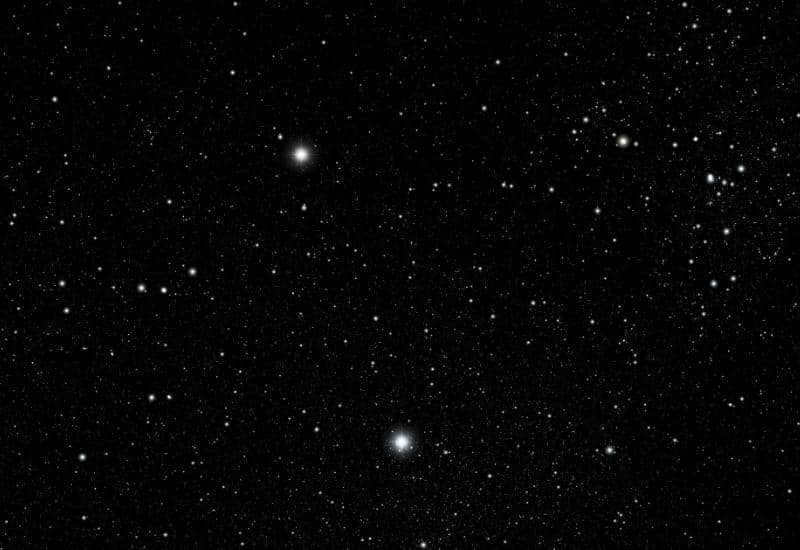
Hipparchus made the decision to quantify the level of brightness by creating a scale consisting of 6 different stellar magnitudes. This scale proved to be quite convenient to use, although the results obtained were somewhat subjective and dependent on the observer’s perception. As a result, this scale only measures the apparent stellar magnitude.
However, in order to perform accurate calculations, a more rigorous and objective approach was required. This approach was only found in the 19th century, thanks to the astronomer Norman Pogson.
Based on his observations, Pogson determined that the difference in stellar magnitudes on the scale is equivalent to a factor of 2.5. In other words, a celestial object with a magnitude of 0 shines 2.5 times brighter than a star with a magnitude of 1.
Stellar Magnitude Classification
There are 5 stellar magnitudes based on the sensitivity of the radiation receiver:
- Visual: This magnitude considers only the brightness range visible to the naked eye.
- Bolometric: This magnitude takes into account all spectra, covering the full range of brightness.
- Photographic: The brilliance is determined by considering the sensitivity of photocells to light.
- Blue: This magnitude focuses on the blue spectral zone.
- Ultraviolet: Measurement is done in the ultraviolet range.
Based on how much physical parameters affect this measure, it is further divided into the following:
- The brightness of a celestial body is visible and depends on the observer’s position in space and the distance from the body. The power of radiation also plays a significant role.
- Absolute stellar magnitude is solely based on the power of a celestial body and is not influenced by the observer’s location. It is measured using precise data.
The definition of absolute stellar magnitude varies depending on the type of object.

It is defined as the apparent stellar magnitude if:
- the distance to a star is 10 parsecs;
- the distance to an object in the solar system is 1 astronomical unit (a.u.) from the Sun, and it would appear in full phase to the viewer, with the viewer also being 1 a.u. away from the object itself;
- the distance to a meteor is 100 kilometers and it is directly above the observer.
Astronomers do not prefer any specific system of calculation, but use both the visible and absolute magnitudes.
Interestingly, magnitudes can be both positive and negative. For example, the absolute magnitude of the Sun is -26.7, while the full Moon has an absolute magnitude of -12.74.
What is the equivalent of stellar magnitude?
Every celestial object has its own measure of brightness. Some of them are variable, meaning their luminosity can change slightly.
Presented below is a table displaying the stellar magnitude of prominent stars:

Various units are employed in measuring luminosity, such as watts (W), joules (J/s), and ergs (erg/s). Multiple equations exist for calculating luminosity.
The most straightforward of these equations:
In this case, knowledge of the star’s absolute magnitude is required. Hence, these indices are interrelated.
Utilization of Stellar Magnitudes
Scientists in the field of astronomy exclusively employ stellar magnitudes for various calculations and to facilitate the study of celestial entities. By comparing apparent and absolute values, it becomes possible to determine the distance between us and a luminous object.
- Apparent stellar magnitude (m) refers to the brightness of a celestial body as seen from Earth, taking into account the illumination produced by the body. This measurement is typically adjusted to account for the absence of an atmosphere. The smaller the stellar magnitude, the brighter the object.
The term “apparent” is used to indicate that this stellar magnitude is observed from Earth, distinguishing it from absolute magnitude. It does not specify the visible range, as magnitudes measured in other ranges such as infrared are also considered visible. A measurement taken in the visible range is referred to as visual.
Related terms
Orbital period – the amount of time it takes for a celestial body to complete one revolution around an external center of gravity or around a common center of mass with another celestial body.
Light year (Russian: sv. year; international: ly) – a unit of measurement used in astronomy to represent the distance that electromagnetic waves (such as light) travel in a vacuum over the course of one Julian year, without being affected by gravitational fields. Although it is not part of the SI system, it is commonly used in the field of astronomy.
The Sun (ast. ☉) is a star located within our Galaxy (known as the Milky Way) and is the only star in our Solar System. Other celestial objects, such as planets and their moons, dwarf planets and their moons, asteroids, meteoroids, comets, and space dust, orbit around the Sun.
Gemini (Latin: Gemini) is a constellation located in the northern hemisphere of the sky. It features two of the brightest stars, Pollux and Castor, with visual sidereal magnitudes of 1.16 and 1.59, respectively. The Sun is within the boundaries of Gemini from June 20 to July 20. The best time to observe Gemini is during December and January. It can be seen throughout Russia.
An orange dwarf is a type of main-sequence star that belongs to the spectral class K and luminosity class V. These stars occupy an intermediate position between red dwarfs (class M) and yellow dwarfs (class G) on the main sequence. Orange dwarfs have masses ranging from 0.5 to 0.8 times that of the Sun and an effective temperature between 3900 and 5200 K.
References mentioned in the literary works
The brightness of an L star is often measured in units of the Sun’s brightness. The Sun’s brightness is equal to 4×1033 erg/s. The brightness of stars can vary greatly. There are stars (although they are relatively rare) that are tens or even hundreds of thousands of times brighter than the Sun. The majority of stars are “dwarfs” with much lower brightness compared to the Sun, often thousands of times lower. The measure of brightness is known as the star’s absolute magnitude. The apparent magnitude of a star depends on its brightness and color, as well as its distance. If we bring any star to a standard distance of 10 pc, its magnitude is called “absolute”. Let’s illustrate this with an example. If the Sun’s apparent magnitude (determined by its radiation flux) is -26.8, then at a distance of 10 pc (which is about 2 million times the actual distance from Earth to the Sun), its magnitude would be around +5. At such a distance, our Sun would appear as a faint star, barely visible to the naked eye (keep in mind that the faintest stars visible to the naked eye have a magnitude of +6). Stars with high brightness have negative absolute magnitudes, such as -7, -5. Stars with low brightness have large positive values of absolute magnitudes, for example +10, +12, and so on.
It is important to keep in mind that the stellar magnitude, also known as the apparent stellar magnitude, does not describe the size or true brightness of the star, but rather its brightness in relation to the observer on Earth.
Once the orbital elements are determined and the values of r, ?, and β are calculated, formula (3.6) can be used to find the absolute stellar magnitude if there are observations of the apparent stellar magnitude. To determine the parameter G, observations of the apparent stellar magnitude at different phase angles are necessary. Currently, the value of the G parameter has been determined for only 114 asteroids, including several ASWs. The determined values of G range from -0.12 to 0.60. For other asteroids, the G value is assumed to be 0.15.
Polaris, also known as the North Star, is the most brilliant star in the constellation of Ursa Minor, or the Little Bear. It is located at the end of the bear’s “tail”. Positioned about 450 light years away from Earth, Polaris has an apparent stellar magnitude of approximately two. This yellow supergiant star is around 10 times the mass of our Sun and has a radius about 70 times greater. While its surface temperature is only slightly higher than that of the Sun, at approximately 7,000 degrees, Polaris shines about 5,000 times more powerfully. In 1780, the famous astronomer William Herschel made the remarkable discovery that Polaris is actually a binary star system. The second component of this system is a yellowish-white star, slightly larger than our Sun, with a magnitude of 9. The primary star in the system is a Cepheid variable, a type of star that exhibits regular changes in brightness. Historically, Polaris had a variability of 0.12 star magnitude with a period of just under four days. However, in the mid-1990s, its variability decreased to 0.02 star magnitude, indicating that it has entered a more stable phase. Polaris is currently moving towards the Sun at a speed of approximately 17 kilometers per second.
Besides the obvious stellar magnitude, there is also what is known as the absolute stellar magnitude. This concept is purely theoretical and comes from a hypothetical scenario: what if all stars were located at a distance of 10 parsecs from us, what would be their apparent brightness? In simpler terms, absolute brightness refers to the brightness of a star that we would observe if we were to bring the star closer to a distance of 10 parsecs from Earth. In this scenario, all stars would be on an equal playing field, allowing us to determine which ones truly emit more light and which ones are comparatively weaker.
Continuation of Related Concepts
A yellow dwarf refers to a category of modest main-sequence stars with masses ranging from 0.8 to 1.2 solar masses and surface temperatures ranging from 5000 to 6000 K. As indicated by their name, they appear yellow based on photometric data, although humans subjectively perceive their color as the utmost purity of white (hotter stars are perceived as bluish or blue by humans). These stars primarily derive energy from thermonuclear fusion, where helium is produced from hydrogen. The most renowned example of a yellow dwarf is.
A carbon star is a type of star that is classified as a red giant or, in some cases, a red dwarf. Unlike other stars, carbon stars have an atmosphere that contains more carbon than oxygen. In the upper layers of the star, the carbon and oxygen mix together to form carbon monoxide. This process binds all of the oxygen in the atmosphere, allowing the carbon atoms to be free and form other carbon compounds. As a result, carbon stars have a blackish atmosphere and appear bright red when observed from the outside.
On the other hand, a red giant is a type of star that belongs to the late spectral classes and has a high level of luminosity. These stars also have extended envelopes. Some examples of red giants include Arcturus, Aldebaran, Hakruks, and Mira.
Mirids are a category of pulsating celestial objects known as variable stars, which were named after the star Mira located in the constellation Keith. This particular class comprises stars that belong to the late spectral classes and exhibit light fluctuations exceeding 2.5 magnitudes in the visible spectrum. The duration of their pulsation cycle can vary between 80 and 1000 days. Mirids are colossal giants in the advanced stages of stellar development, and over the course of several million years, they gradually shed their outer layers, ultimately transforming into white dwarfs.
Semi-regular variable stars are a type of long-period pulsating stars that exhibit noticeable periodicity and significant irregularities in their light variations. These stars, which can be giants or supergiants with intermediate to late spectral types, display considerable periodicity in their changes in brightness, often accompanied or occasionally interrupted by various irregularities. The duration of their light variations can range from 20 to 2000 or more days, and the shapes of their light curves can vary.
Delta Shield type variable stars (δ Sct) are characterized by dramatic changes in luminosity caused by both radial and non-radial pulsations occurring on the star’s surface.
Volopassus (Latin Boötes from Greek Βοώτης, “plowman (on oxen)”; Boo) is a constellation located in the northern hemisphere of the sky. The best time for observing it is during spring and the first half of summer. This constellation can be seen from all parts of Russia.
Andromeda (Latin: Andromeda) is a constellation located in the northern hemisphere of the night sky. It consists of three stars with a magnitude of two and the spiral galaxy Andromeda (M31), which can be seen with the naked eye and has been known since the 10th century.
A binary star, also known as a double system, is a pair of stars that are gravitationally bound and revolve around a common center of mass. Binary stars are quite common in the universe, with approximately half of all stars in our Milky Way galaxy being part of a binary system.
A variable star is a celestial object whose brightness fluctuates over time due to physical processes occurring in its vicinity. Technically, the luminosity of any star undergoes some degree of change as time passes. For instance, the Sun’s energy output varies by 0.1% during an eleven-year solar cycle, resulting in a minuscule alteration of its absolute magnitude. A variable star, on the other hand, refers to a star whose fluctuations in brightness have been consistently observed and documented.
The Big Dipper, also known as Ursa Major in Latin, is a constellation visible in the northern hemisphere. Consisting of seven stars, the Big Dipper resembles a dipper or a ladle with a handle. The two brightest stars in this pattern, Alioth and Dubhe, have an apparent sidereal magnitude of 1.8. Furthermore, the two outermost stars in this configuration, designated as alpha and beta, can be utilized to locate Polaris, the North Star.
Volk (Latin: Lupus) is a constellation in the southern hemisphere of the sky, situated between Centaurus and Scorpius. In Russia, it can be observed partially in the central and southern regions, but it is fully visible south of 35° N latitude. The brightest star in the constellation, α Wolf, has a magnitude of 2.3m; in the territory of Russia, this star only rises in the southern part of Dagestan. The optimal visibility conditions occur in May.
A subgiant refers to a former main-sequence star that is similar to the Sun or slightly more massive. It has exhausted its hydrogen fuel in the core and has started hydrogen burning in the core shell, but helium burning has not yet commenced.
The annual parallax of a star is a phenomenon that occurs due to the Earth’s revolution around the Sun, resulting in a change in the star’s coordinates as observed by an observer on Earth. This parallax is a crucial piece of evidence for the Earth’s motion around the Sun and serves as the primary method for measuring distances to stars. The annual parallax of a specific star is determined by the angle at which the major semi-axis of the Earth’s orbit is visible from the star’s location. Given the vast distances to stars, even the closest ones exhibit annual parallaxes that are less than one second of arc.
On a different note, the red dwarf, as indicated by the Hertzsprung-Russell diagram, is a type of star that falls into the small and relatively cool category within the main sequence. These stars typically have spectral classes M or late K.
Veronica Volosi, also known as Coma Berenices, is a constellation located in the northern hemisphere of the sky. It covers an area of 386.5 square degrees and contains 64 stars that can be seen without the aid of a telescope. Out of these stars, 50 are brighter than magnitude 6. Within this constellation, you can find the north pole of the Galaxy and observe thousands of galaxies along with hundreds of galaxy clusters.
Bright giants are a type of star that falls between giants and supergiants in terms of size. These stars have luminosities similar to supergiants, but they are generally not as massive. The mass of a bright giant star is typically no more than a few times that of our Sun.
A multiple star is composed of three or more stars that appear close to each other when observed from Earth. This closeness can either be a result of apparent proximity, where stars at different distances appear close in the line of sight, or it can be due to the stars being physically close and gravitationally bound together, making them physically multiple. Physically multiple stars are a specific type of multiple star system.
A star is a massive sphere of gas that emits light and is held in equilibrium by the forces of gravity and internal pressure. Fusion reactions occur (or have occurred in the past) within its core. The Sun, which belongs to the G spectral class, is the closest star to Earth and serves as a typical example of a star.
The Bortle scale, which measures the brightness of the night sky at a specific location, is a unique nine-level scale. It provides a way to quantify the visibility of celestial objects and the disruption caused by light pollution. The scale was developed by John E. Bortle, who introduced it in the Sky & Telescope journal in February 2001. Its primary purpose was to assist amateur astronomers in gauging the level of darkness at a particular observing site and to facilitate comparisons between different sites. The scale is categorized into various classes.
An exoplanet, also known as an extrasolar planet, is a celestial body located outside of our solar system. The quest to identify planets orbiting other stars has been a long-standing challenge due to their small size and faintness in comparison to the stars themselves. Moreover, the vast distances between these stars and our Sun, with the closest one being 4.24 light-years away, make the task even more difficult. Nonetheless, the first exoplanets were successfully detected in the late 1980s.
The term “naked eye” is a metaphorical phrase that describes the visual perception of individuals who do not require any additional aids such as telescopes, microscopes, magnifying glasses, spectacles, monocles, lenses, or binoculars. These individuals possess normal vision and are able to see without any assistance. However, individuals with vision impairments rely on glasses or lenses to enhance their visual abilities.
The Canis Major, also known as the Big Dog in Latin, is a constellation that can be seen in the southern hemisphere of the sky. The brightest star in this constellation is Sirius, which shines with a brilliance of -1.46m. The best time to observe Canis Major is during the months of December and January. It is situated to the southeast of Orion, appearing “under the right foot.” Additionally, Canis Major is partially located within the Milky Way. In Russia, this constellation can be fully observed in the southern and central regions, and partially in the northern regions.
Aquarius, or Aquarius in Latin, is a large constellation that falls between Capricorn and Pisces. Within Aquarius, there is a famous asterism known as the Jug. This small group of five stars forms a Y-shape and can be found along the celestial equator. One of the stars in the Jug, ζ Aquarius, is actually a double star. Other interesting celestial objects within Aquarius include the globular cluster M 2 and the planetary nebulae Saturn and Snail (NGC 7009 and NGC 7293). Aquarius is also the location of the radiant for the Delta Aquaridae meteor shower, which is active in late July.
Brown Curlies, also known as Brown Curlies (“substars” or “chemical stars”), are substellar objects that have masses ranging from 0.012 to 0.0767 solar masses, or 12.57 to 80.35 Jupiter masses, respectively. Similar to stars, they experience thermonuclear reactions involving the fusion of light elements such as deuterium, lithium, beryllium, and boron. However, unlike main-sequence stars, the contribution of hydrogen fusion reactions (involving protons) to the release of heat in these stars is insignificant, and eventually becomes depleted.
Dwarf novae or U Gemini stars (U Gem, UG) are a class of cataclysmic variable stars – a binary star system in close proximity where one of the stars is a white dwarf that accumulates matter from its companion. They share similarities with classical nova stars in that the white dwarf undergoes periodic outbursts, but the causes of these outbursts differ: in classical nova stars, the outburst is triggered by a thermonuclear reaction and the detonation of accumulated hydrogen, whereas in dwarf novae, the mechanisms behind the outbursts vary.
Spectral classes categorize stars according to their emission spectrum, predominantly the temperature of the photosphere. Variations in star spectra occur because of diverse physical characteristics of their atmospheres, primarily temperature and pressure (which determine atom ionization levels). The spectrum type is also influenced by the existence of magnetic and interatomic electric fields, disparities in chemical composition, stellar rotation, and other factors.
The constellation Libra, also known as Scales in Latin, is situated between Scorpio and Virgo in the zodiac. It consists of 83 stars that can be seen with the naked eye. Despite the fact that only six of its stars have a brightness greater than 4th magnitude, Libra is one of the most prominent constellations in the Zodiac. From October 31 to November 22, the Sun is located in this constellation. The best time for observing Libra is in April and May. It is fully visible in the central and southern regions of Russia.
Irregular variable stars are a specific type of variable stars that exhibit brightness fluctuations according to a non-periodic pattern. There are two main categories of irregular variables: eruptive and pulsating.
Supergiants, which are located in the upper part of the Hertzsprung-Russell diagram, are some of the most massive stars. In the Yerkes classification, supergiants are divided into two classes: Ia, which are bright supergiants, and Ib, which are less bright supergiants. The total (bolometric) absolute stellar magnitude of a supergiant usually falls between -5m and -12m. Superbright supergiants that have a magnitude brighter than -8m are often classified as hypergiants.
The constellation Swan can be found in the northern hemisphere of the sky. Its bright stars form a distinct cross-shaped pattern known as the Northern Cross asterism, which stretches along the Milky Way. Ancient civilizations associated this constellation with flying birds. The Babylonians referred to it as the “forest bird,” while the Arabs called it a chicken.
White dwarfs are stars that have evolved and have masses that do not exceed the Chandrasekar limit, which is the maximum mass at which a star can exist as a white dwarf. They do not have their own sources of thermonuclear energy.
Constellations are areas in modern astronomy that divide the celestial sphere for easy orientation in the starry sky. In ancient times, constellations were recognizable figures formed by bright stars.
Lyra (Guj. લેયરા, Latin Lyra, Lyr) is a small constellation in the northern hemisphere, located between Hercules and Swan.
Cancer (Latin. Cancer) is the least noticeable zodiacal constellation, only visible on a clear night between the constellations Leo and Gemini. The brightest star (β Cancer) has an apparent magnitude of 3.53m.
A giant star is a stellar object that has a significantly larger radius and higher luminosity than main-sequence stars with the same surface temperature. Typically, giant stars have radii ranging from 10 to 100 times that of the Sun and luminosities ranging from 10 to 1000 times that of the Sun. Stars with even higher luminosities are known as supergiants and hypergiants. White giants are a subset of hot and bright main-sequence stars. These giants have a larger radius and higher luminosity due to their accretion of matter from the surrounding space by gravitational attraction. Accretion is the process by which the mass of a celestial body increases through the gravitational attraction of matter, usually gas, from its surrounding space.
Pegasus, also known as Latin. Pegasus, is a constellation that can be found in the starry sky of the northern hemisphere. It can be found in the southwest region of Andromeda. Covering an impressive area of 1120.8 square degrees, Pegasus is home to 166 stars that can be seen with the naked eye.
Hercules, another constellation in the northern hemisphere, is visible throughout Russia. It covers a vast area of 1,225.1 square degrees and boasts 235 stars that can be seen without the aid of a telescope. In the southern regions of Russia and the former USSR, Hercules reaches its highest point in the sky. The best time to observe this constellation is in June.
Virgo, a zodiacal constellation, can be found between Leo and Libra along the celestial equator. In modern times, the autumnal equinox point is located within the boundaries of Virgo.
Scorpio (Latin: Scorpius) is a constellation in the southern part of the sky. It is situated between Sagittarius in the east and Libra in the west, and it is completely within the Milky Way. Serpentor is located to the north of Scorpio, while Sacrilege is located to the south.
Serpens is a constellation that is located along the celestial equator. It covers an area of 636.9 square degrees in the night sky and contains 106 stars that can be seen without the aid of a telescope. The best time to see Serpens is in June, and it can be seen from all parts of Russia. It is unique because it is the only constellation that is made up of two unrelated parts. These parts are separated by the constellation Serpentine. The “Snake’s Head” is located to the northwest, while the “Snake’s Tail” is located to the east.
This compilation of the nearest stars to our planet, arranged in ascending order of their proximity, consists of stars located within a 5 parsec (equivalent to 16.308 light-years) radius from Earth. Within this limited range, there are presently 57 identified stellar systems, which encompass a combined count of 64 stars and 13 brown dwarfs, in addition to our very own Sun.


- Home
- Stellar Objects
Regarding the brightness and hues of stars
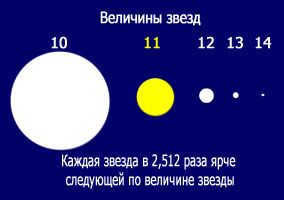
The luminosity or visible magnitude of celestial objects is a metric that quantifies the brightness of a source at the point of observation where its rays intersect a surface perpendicular to it.
Scales of stellar magnitudes
By using a photometer to measure the light ratio of stars, it is possible to determine the difference in stellar magnitudes based on Pogson’s formula (relative to the known zero point of the stellar magnitude scale):
m2 – m1 = -2.5 (lgE2 – lgE1) .
The zero point is chosen conventionally, following the conventions associated with the selection of the photometric standard. Initially, this standard was the stellar magnitude of Polaris, and later the stellar magnitudes of approximately 100 stars in the North Polar series.
The values of m and n can also be decimal, as stellar magnitudes are not necessarily whole numbers.
The measurement of the brightness of stars is based on a logarithmic scale known as stellar magnitude. A change in luminosity by a factor of 2.512 is considered as a difference of 1 magnitude (1 m). The decimal logarithm of this ratio is 0.4, and an interval of 5 magnitudes corresponds to a ratio of 100 times.
The human eye can perceive objects with a magnitude of about 6 m, but with a large telescope, objects with a magnitude of up to 19 m can be seen. It is even possible to capture images of objects with a magnitude of up to 22 m.
A star with a magnitude of 1 m is 100 million times brighter than a star with a magnitude of 21 m.
On the other hand, a star with a magnitude of 23 m is 630 million times less bright than a star with a magnitude of 1 m.
Although stellar magnitude is primarily used for individual stars, it can also be applied to extended objects by measuring the radiation flux they emit.
By measuring the illuminance produced by the Sun, the full Moon, and the planets, we can determine their corresponding stellar magnitudes.
| The Sun | -26 m ,8 |
| Moon (full moon) | -12 m ,7 |
| Venus (greatest elongation) | -4 m ,1 |
| Jupiter (in opposition) | -2 m ,4 |
| Sirius | -1 m ,46 |
The total count of stars with the magnitude of one is 20, with the magnitude of two – 60, with the magnitude of three – 170, with the magnitude of four – 400, with the magnitude of five – 1100, with the magnitude of six – 4000, and so on. Approximately 300,000 stars have the magnitude of nine.
After the invention of the photometer, the brightness of a star was measured by comparing it to a reference star and equalizing their brightness.
These estimates were made visually and are referred to as visual stellar magnitudes.
The Colors of Stars
Stellar magnitudes vary depending on the part of the spectrum in which they are measured.
The color characteristics of the stellar magnitude system are determined by the range of wavelengths that the receiver detects.
The human eye is most sensitive to yellow-green rays.
Photographed stellar magnitudes may differ slightly from visual magnitudes.
This difference between photographic and visual stellar magnitudes is known as the color index.
For white stars, the color index is typically zero.
Red stars, however, will have a positive color index because photographic plates do not detect red rays. As a result, a red star with a visual magnitude of 5m may appear to have a magnitude of 8m on a photographic plate.
The bolometric magnitude is the measurement of the total energy emitted across the entire spectrum of a star.
By measuring the flux of radiation through visual, photographic, and photoelectric methods, we can establish systems for determining stellar magnitudes.
Although visual and photographic methods are not precise enough for determining stellar magnitudes.
A more accurate method is the photoelectric method, which has an error range of 0 m.01 to 0 m.02.
The photoelectric method utilizes the phenomenon that certain substances produce an electric current when illuminated, and the strength of this current is proportional to the intensity of the incident light. This allows for more precise measurements of “light” quantities.
As a result, there have been developments in more convenient photometric systems for measuring stellar magnitudes.
System U, for example, measures stellar magnitudes in the ultraviolet region of the spectrum with an average wavelength of 3640 A.
System B, on the other hand, is designed for the photographic region and is calibrated to a wavelength of 4445 A.
System V corresponds to the visual spectrum and is set to a wavelength of 5505 A.
Systems R and I, on the other hand, are specific to the infrared region.
The UBVRI system has been universally adopted by the International Astronomical Union as a standard.
Zero points are defined by specially selected stars, which serve as reference points for measuring stellar magnitudes in each established color. All other stars are compared to these reference standards.
Each star’s color is characterized by its color index.
Multiple color indices, such as U-B, B-V, V-R, R-I, can be determined for each star to compare the intensity of radiation in different parts of the spectrum.
The system of bolometric stellar magnitudes combines all radiations of a star in all parts of the spectrum.
Due to strong absorption by the Earth’s atmosphere, starlight with wavelengths shorter than 0.3 microns cannot be measured using the standard system, unless stars are observed from space.
Research is currently being conducted at space stations in Earth orbit.
The Earth’s atmosphere presents significant challenges to observation at certain wavelengths due to its strong light absorption. For instance, light in the range of 1 to 4 µm, as well as near 1.8 and 2.8 µm, is heavily absorbed. However, there are transparency windows around 1.3, 2.2, and 3.4 µm.
To ensure satisfactory observations, it is sometimes necessary to choose dry weather and ascend mountains higher than 2700 m to minimize water vapor above the instrument.
Another approach to mitigate atmospheric absorption is to conduct observations from airplanes flying at altitudes of 12-15 km.
An important goal of photometry is to establish an extensive and comprehensive network of standard stars in the sky, with known stellar magnitudes and colors.
To achieve this, precise measurements need to be taken using specific filters and photocells that have consistent properties.
Harold Johnson conducted these measurements for the UBV color system. His lists include data on several hundred stars.
For stars that are closest to us, the color index directly reflects the star’s temperature.
Stars that are white-blue and have a surface temperature of 25000 K emit significantly more intense blue light compared to red stars with a surface temperature of 3000 K.
The light from distant stars is heavily reddened due to the presence of cosmic dust between the stars.
By analyzing the spectrum of a star, we can often determine its true color index before it was absorbed by the interstellar medium.
By knowing the actual color index, we can compare it to the observed index and determine the extent of reddening caused by interstellar dust. This allows us to gather information about the absorption of light by dust in the Milky Way system.
Absolute stellar magnitudes
The perceived brightness and apparent magnitude of a star are dependent on its distance from the observer, represented by r. To eliminate the influence of distance, the concept of absolute luminosity and absolute magnitude of a star was introduced.
The absolute luminosity of a star, denoted as L, is the luminosity it would possess if it was placed at a distance of 10 parsecs from the observer.
Since luminosity decreases inversely with the square of the distance, the absolute luminosity L and the apparent luminosity l are linked by the equation:
L/l = r 2 /100 = 2.512 m-M .
The value of m represents the apparent stellar magnitude, while M represents the absolute stellar magnitude. The absolute magnitude is defined as the magnitude a star would have if it were moved to a distance of 10 parsecs.
Using the ratio above, we can derive the following formula:
M = m + 5 – 5lg r .
When considering interstellar absorption, the formula can be modified accordingly:
M = m + 5 – 5lg r – A(r) .
Given that A(r) represents the light absorption that is directly proportional to the distance to the star, this equation enables us to determine the absolute stellar magnitude of a star when the distance is provided. Conversely, it also enables us to determine the distance when the absolute magnitude is known, using the following formula:
lg r = (m – M)/5 + 1 .
Absolute stellar magnitudes can be classified into three categories: bolometric, visual, and photographic.
The absolute stellar magnitude of the Sun is +4.7 m .
The luminosity of a star is often expressed as the ratio of its absolute luminosity to that of the Sun.
The most luminous stars are 14 m brighter than the Sun and emit energy at a rate that is 1,000,000 times higher. On the other hand, the least luminous stars are 14 m fainter and emit energy at a rate that is 300,000 times lower.
The ratio of the luminosities of the brightest and faintest stars can reach up to 100 billion.
Source: Abridged
Stellar magnitude, also known as luminosity, is a non-dimensional numerical measure of an object’s brightness. This term is commonly used to describe celestial bodies. Stellar magnitude quantifies the energy flux (the energy of all photons per second) per unit area emitted by the celestial body in the visible, near-infrared, and ultraviolet regions of the electromagnetic spectrum. Hence, stellar magnitude is influenced by both the intrinsic properties of the object itself (such as luminosity) and its distance. The lower the value of the stellar magnitude, the brighter the object appears.
Definition
In the 2nd century BC, the ancient Greek astronomer Hipparchus classified stars into six magnitudes. He referred to the brightest stars as first magnitude stars, the dimmest stars as sixth magnitude stars, and evenly distributed the others among the intermediate magnitudes.
Later on, it was discovered that the relationship between this scale and actual physical magnitudes is logarithmic. This is because the eye perceives a change in brightness by the same amount when it changes by the same number of times (Weber-Fechner’s law). Consequently, in 1856, Norman Pogson proposed the following formalization of the stellar magnitude scale, which became widely accepted [1] [2]:
In this formula, the stellar magnitudes (m) represent the brightness of the objects, while the luminosities (L) indicate the amount of light emitted by the objects. This definition implies that the light flux decreases by a factor of 100 when the stellar magnitude increases by 5 units.
Using this formula, we can determine the difference between stellar magnitudes, but not the magnitudes themselves. To establish an absolute scale, it is necessary to define a zero point – a luminosity that corresponds to a stellar magnitude of zero (0 m). Initially, the luminosity of Vega was chosen as the zero point. Although the zero point has been redefined, Vega still serves as a standard for zero stellar magnitude in visual observations. According to the modern system, in the V band of the UBV system, Vega has a luminosity of +0.03 m, which is practically indistinguishable from zero to the naked eye.
According to current measurements, a star with a magnitude of zero outside of Earth’s atmosphere has an illuminance of 2.54-10 -6 lux. The brightness from a star with a magnitude of 0 is approximately 10 3 quanta /(cm²-s-Å) in green light (band V of the UBV system) or 10 6 quanta /(cm²-s-Å) in the entire visible light range.
The following characteristics aid in the practical use of visible stellar magnitudes:
- An increase in luminous flux by a factor of 100 corresponds to a decrease in apparent stellar magnitude of exactly 5 units.
- A decrease in stellar magnitude of one unit translates to an increase in luminous flux by a factor of approximately 2.512.
In modern times, the notion of stellar magnitude is applied to not just stars, but also to various other celestial bodies including the Moon, Sun, and planets. The stellar magnitude of the most brilliant objects is represented by negative values. For instance, the luminosity of the Moon during a full phase reaches -12.7 m, while the brilliance of the Sun is measured at -26.7 m.
Spectral Dependence
The apparent magnitude of a star is influenced by the spectral sensitivity of the radiation receiver (such as the human eye, photoelectric detector, or photographic plate).
The UBV system is the most commonly used photometric system, which includes three overlapping bands that cover different wavelength intervals. Within this system, three stellar magnitudes can be measured for each celestial object:
- The stellar magnitude in the “blue” region (B) represents the brightness of an object in the blue part of the spectrum, with maximum sensitivity at a wavelength of approximately 445 nm.
- The stellar magnitude in the ultraviolet region (U) has its maximum sensitivity at a wavelength of approximately 350 nm.
Indicators of an object’s color can be observed through differences in stellar magnitudes across different bands, such as the UBV system’s U-B and B-V. The larger these differences are, the more reddish the object appears. The UBV photometric system has been established to ensure that stars of spectral class A0V have color indices of zero.
Other measurements of stellar brightness
- Bolometric stellar magnitude measures the total amount of radiative power emitted by a star across all wavelengths. This magnitude is determined using a specialized device called a bolometer. It is important because certain stars, such as very hot or very cold ones, emit most of their radiation outside of the visible spectrum.
- Absolute stellar magnitude (M) is the magnitude that an object would have if it were located 10 parsecs away from the observer. The absolute bolometric stellar magnitude of the Sun is +4.8 m.
- The photographic stellar magnitude is measured by using unsensitized photoemulsion with a spectral sensitivity that peaks at a wavelength of 425 nm. It is defined as being the same as the visual stellar magnitude for A0V stars and has a brightness of (6.0±0.5) m.
Stellar magnitudes of various objects
| Sun | -26.7 (400,000 times brighter than the full Moon) |
| Full Moon | −12.74 |
| Iridium Flash (at its maximum brightness) | −9.5 |
| Supernova in 1054 (at its maximum brightness) | −6.0 |
| Venus (at its maximum brightness) | −4.67 |
| International Space Station (at its maximum brightness) | −4 |
| Earth (when viewed from the Sun) | −3.84 |
| Jupiter (at its maximum brightness) | −2.94 |
| Mars (at its maximum brightness) | −2.91 |
| Mercury (at its maximum brightness) | −2.45 |
| Saturn (at its maximum brightness) | +0.7 |
| Stars of the Big Dipper | +2 |
| Andromeda Galaxy | +3.44 |
| Jupiter’s satellites | +5-6 |
| Uranus | +5.5 |
| The faintest stars visible to the naked eye | +6 to +7.72 |
| Neptune | +7.8 |
| Proxima Centauri | +11.1 |
| Brightest quasar | +12.6 |
| The faintest object captured by an 8-meter ground-based telescope. | +27 |
| The faintest object captured by the Hubble Space Telescope. | +31.5 |
| Sirius | Canis Major | −1.47 |
| Canopus | Carina | −0.72 |
| α Centauri | Centaurus | −0.27 |
| Arcturus | Boötes | −0.04 |
| Vega | Lyra | +0.03 |
| Capella | Auriga | +0.08 |
| Rigel | Orion | +0.12 |
| Procyon | Canis Minor | +0.38 |
| Ahernar | Eridanus | +0.46 |
| Betelgeuse | Orion | +0.50 |
| Altair | Aquila | +0.75 |
| Aldebaran | Taurus | +0.85 |
| Antares | Scorpius | +1.09 |
| Pollux | Gemini | +1.15 |
| Fomalhaut | Piscis Austrinus | +1.16 |
| Deneb | Cygnus | +1.25 |
| Regulus | Leo | +1.35 |
| Directly on the surface of the Sun (total from the entire disk) | −38.4 |
| Icarus (perihelion) | −30.4 |
| Mercury (perihelion) | −29.3 |
| Venus (perihelion) | −27.4 |
| Earth | −26.7 |
| Mars (aphelion) | −25.6 |
| Jupiter (aphelion) | −23.0 |
| Saturn (aphelion) | −21.7 |
| Uranus (aphelion) | −20.2 |
| Neptune (aphelion) | −19.3 |
| Pluto (aphelion) | −18.2 |
| 631 a.u. (brightness of the full Moon) | −12.7 |
| Sedna (aphelion) | −11.8 |
| 2006 SQ372 (aphelion) | −10.0 |
| Comet Hyakutake (aphelion) | −8.3 |
| 0.456 sv. year (brightness of Venus) | −4.4 |
| Alpha Centauri | 0.5 |
| 55 sv. years (visibility threshold) | 6.0 |
| Rigel | 12.0 |
| Andromeda Nebula | 29.3 |
| 3C 273 (brightest quasar) | 44.2 |
| UDFj-39546284 (farthest astronomical object as of 2011, taking redshift into account) | 49.8 |
Additional Resources
Important Information
- ↑ Stars / Surdin V.G.. – Moscow: Fizmatlit, 2009. – p. 63.
- ↑Surdin V. Г.Stellar magnitude (Russian) . Astronet.ru Glossary. Archived from the original source on November 28, 2010.Checked September 16, 2012.
- ↑ The calculation is based on the assumption that the stellar magnitude at a distance of 1 a. f. is -26.7, which corresponds to the Sun’s absolute stellar magnitude of +4.87.
References
- Mironov A. В.Precision photometry. “Astronet. Archived from the original source on October 17, 2012.Checked August 28, 2012.
- Determining stellar magnitude in an image. “Astrotourist”. Archived from the original source on May 11, 2012.Checked November 20, 2009.

Here are the responses to the queries from the second session titled “Starry sky. Celestial Sphere” in the Astronomy workbook for 11th graders. Any questions or comments regarding the session can be posted on the discussion page.
Starry Sky. Celestial Sphere [ edit correct code ].
Constellations [edit the correct code]
A constellation is a relatively large region of the sky that includes several bright stars that can be easily seen without any optical aid. Occasionally, these stars are organized in a distinctive and memorable pattern.
Additional information: Currently, there are a total of 88 constellations that divide the sky. These constellations were officially established and named at the first congress of the International Astronomical Union (IAU) in 1922. The boundaries of the constellations align with the meridians and parallels of the equatorial coordinate system. In order to create a modern list of constellations, 27 constellations from separate catalogs and atlases had to be excluded. Out of the 88 constellations, 48 of them existed prior to the modern list, with some dating back to ancient times. The names of the remaining 40 constellations, mostly from the southern sky, were introduced in the late 19th and early 20th centuries.
Several constellations in the sky [edit edit code].
- By utilizing a stellar chart, input the illustrations of constellations containing prominent stars into the designated fields in the table. Within each constellation, locate the most luminous star and provide its designation
| Ursa Major |  | Alioth |
| Vulpecula |  | Arcturus |
| Leo |  | Regulus |
| Gemini |  | Pollux |
| Cygnus |  | Deneb |
| Orion |  | Rigel |
| Auriga |  | Capella |
Star charts are not designed to show the positions of planets, as the planets move relative to the stars at a rapid pace. However, in specific coordinate systems such as equatorial or galactic, the stars have minimal movement, allowing star charts to remain useful for extended periods of time, often spanning decades or even centuries, unless a very high level of precision is needed. On the other hand, the positions of most planets change significantly over the course of a year, often by tens of degrees. As a result, special maps are published annually for planetary observers, typically found in astronomical calendars and yearbooks. These maps showcase the trajectories of each planet against the backdrop of constellations, with date markings provided.
Stellar magnitude rankings of various stars [ edit edit code ]
- Arrange the following stars in order of decreasing brilliance: 1) Betelgeuse; 2) Spica; 3) Aldebaran; 4) Sirius; 5) Arcturus; 6) Capella; 7) Procyon; 8) Vega; 9) Altair; 10) Pollux.
4 → 5 → 8 → 6 → 1 → 7 → 9 → 3 → 2 → 10
Additional information:
| Sirius | −1.46 |
| Arcturus | −0.05 |
| Vega | +0.03 |
| Capella | +0.08 |
| Betelgeuse | +0.2 |
| Procyon | +0.37 |
| Altair | +0.77 |
| Aldebaran | +0.85 |
| Spica | +1.04 |
| Pollux | +1.15 |
Magnitude of star brightness [ edit edit code ]
Stars with a magnitude of 1 are 100 times brighter than stars with a magnitude of 6.
Further details: Stellar magnitude – Stellar magnitude is a dimensionless measure that describes the brightness of a star or other celestial body relative to its apparent size. In simpler terms, it quantifies the amount of electromagnetic waves emitted by the body that are detected by an observer. The magnitude is influenced by both the properties of the object being observed and the distance between the observer and the object. It specifically applies to the visible, infrared, and ultraviolet ranges of the electromagnetic spectrum. [3]
Ecliptic [ edit edit code ]
The Ecliptic is the apparent path of the Sun on the celestial sphere as seen from Earth. It is the basis for the ecliptic coordinate system, which is used to describe the positions of celestial objects in the sky. The ecliptic is tilted relative to the celestial equator, and the angle between the two is known as the obliquity of the ecliptic. The ecliptic is divided into twelve equal parts, each representing one of the zodiac signs. The ecliptic is an important reference for astronomers and astrologers alike, as it helps to determine the position of the Sun, Moon, and planets in the sky at any given time.
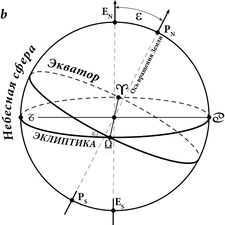
Ecliptic is the term used to describe the celestial sphere that represents the path of the Sun as observed from the Earth. Imagine being able to see the Sun’s motion in relation to the stars and other celestial objects throughout the year. This path is referred to as the ecliptic and is depicted in the diagram above.
As our planet Earth orbits around the Sun, it follows a specific path called the ecliptic plane. This plane can be visualized as an infinite two-dimensional sheet. [4]
The celestial sphere [ edit edit code ]
The celestial sphere is a concept used in astronomy to represent the entire sky as seen from Earth. It is an imaginary sphere surrounding our planet, with the Earth at its center. This concept helps astronomers study the positions and movements of celestial objects such as stars, planets, and galaxies.
The celestial sphere is a useful tool for understanding the positions of objects in the sky. By imagining the sky as a sphere, astronomers can easily visualize and describe the locations of celestial objects. This is particularly helpful when studying the apparent motion of objects due to Earth’s rotation and revolution.
To make the celestial sphere more tangible, astronomers divide it into various coordinate systems. These systems, such as the equatorial and ecliptic coordinate systems, allow astronomers to precisely locate objects on the celestial sphere. They also help astronomers track the motion of objects over time and predict their future positions.
In addition to its practical uses, the celestial sphere is also a valuable concept for understanding the nature of our universe. By visualizing the sky as a sphere, astronomers can better comprehend the vast distances and scales involved in astronomy. It provides a framework for studying and exploring the cosmos beyond our planet.
In conclusion, the celestial sphere is a crucial concept in astronomy that helps astronomers study and understand the positions and movements of celestial objects. By imagining the sky as a sphere, astronomers can better visualize and describe the complex motions and relationships between objects in the sky.
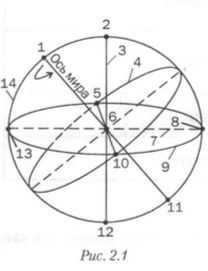
- What is referred to as the celestial sphere?
The celestial sphere is a theoretical notion, an imaginary sphere with an infinitely large radius that has the observer at its center. The center of the celestial sphere is also at the observer’s eye level (in other words, everything visible from the horizon to the horizon above the observer’s head is this very sphere). However, for the sake of simplicity, you can consider the center of the celestial sphere to be the center of the Earth as well, and this assumption is not incorrect. The positions of stars, planets, the Sun, and the Moon are marked on the sphere according to their visible positions in the sky at a specific time and from a specific observer’s location. [5]
- List the names of the celestial sphere points and lines labeled with numbers 1-14 in Figure 2.1:
- North Pole of the World
- Zenith; zenith point
- Vertical line
- Celestial Equator
- West; West point
- Center of the celestial sphere
- Noon Line
- South; Point of South
- Skyline
- East; the point of the east
- South pole of the world
- Nadir; nadir current
- Point of north
- Lines of the celestial meridian [6]
Additional Questions [ edit edit code ]
World axis – An imaginary line that runs through the center of the celestial sphere and is parallel to the Earth’s axis of rotation. The celestial sphere appears to rotate around the world axis. [7]
Celestial meridian – The great circle on the celestial sphere that passes through the world’s poles and the zenith of the observer’s location. The celestial meridian divides the celestial sphere into western and eastern hemispheres and intersects the true horizon at two opposite points, creating the south and north points. [8]
The celestial equator is a significant feature of the celestial sphere. It is a great circle that is perpendicular to the axis of the Earth. This means that it divides the surface of the celestial sphere into two hemispheres: the northern hemisphere, which has its apex at the north pole of the Earth, and the southern hemisphere, which has its apex at the south pole of the Earth. [9]
World Axis [ edit edit code ]
The axis of the world runs parallel to the Earth’s axis of rotation and is located in the plane of the celestial meridian.
The world axis is situated in the same plane. It passes through the Earth’s axis of rotation. The celestial meridian is defined as a straight line that intersects two points equidistant from the center of the celestial sphere. [10] [11]
Celestial equator and meridian [edit edit code]
The intersection of the celestial equator with the horizon line occurs at the eastern and western points.
The intersection of the celestial meridian with the horizon line occurs at the northern and southern points.
Celestial sphere [edit edit code]
During the night, when we gaze upon the starry sky, we have the opportunity to witness the movement of the stars as they revolve around Polaris. This phenomenon is also visible in long exposure photographs of the sky (see figure).
